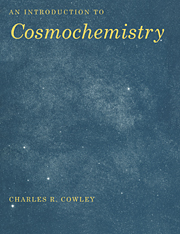Book contents
- Frontmatter
- Contents
- Foreword
- 1 Overview
- 2 Minerals: An Introduction to the Nomenclature and Chemistry
- 3 A Brief Introduction to Petrology
- 4 A Résumé of Thermodynamics and Statistical Mechanics
- 5 Condensation Sequences and the Geochemical Classification of the Elements
- 6 The Theory of the Bulk Composition of the Planets
- 7 Meteorites and the Standard Abundance Distribution (SAD)
- 8 An Introduction to Isotope Geology with an Emphasis on Meteorites
- 9 Some Concepts from Nuclear Physics
- 10 Energy Generation in Stars and Nucleosynthesis
- 11 Atomic and Molecular Spectra
- 12 The Analysis of Stellar Spectra
- 13 The Chemistry of Stars and Stellar Systems
- 14 Cold, Non-stellar Material in Galaxies
- 15 Emission-Line Regions and their Chemical Abundances
- 16 Abundances of the Elements in Galaxies
- Appendix
- References
- Index
7 - Meteorites and the Standard Abundance Distribution (SAD)
Published online by Cambridge University Press: 05 June 2012
- Frontmatter
- Contents
- Foreword
- 1 Overview
- 2 Minerals: An Introduction to the Nomenclature and Chemistry
- 3 A Brief Introduction to Petrology
- 4 A Résumé of Thermodynamics and Statistical Mechanics
- 5 Condensation Sequences and the Geochemical Classification of the Elements
- 6 The Theory of the Bulk Composition of the Planets
- 7 Meteorites and the Standard Abundance Distribution (SAD)
- 8 An Introduction to Isotope Geology with an Emphasis on Meteorites
- 9 Some Concepts from Nuclear Physics
- 10 Energy Generation in Stars and Nucleosynthesis
- 11 Atomic and Molecular Spectra
- 12 The Analysis of Stellar Spectra
- 13 The Chemistry of Stars and Stellar Systems
- 14 Cold, Non-stellar Material in Galaxies
- 15 Emission-Line Regions and their Chemical Abundances
- 16 Abundances of the Elements in Galaxies
- Appendix
- References
- Index
Summary
An Overview
We may divide the meteorites into three broad categories, the stones, the stony-irons, and the irons. Meteorite samples are described as “falls” or “finds.” If a meteorite is observed to fall, and brought to a museum curator, it is called a fall. Finds are meteorites that have not been seen to fall, or at least not by the person who discovers them.
It is now reasonable to speak of two major divisions of meteorites – those discovered in the last several decades in Antarctica, and all of the rest. The Antarctic meteorites have roughly doubled the available samples of solid cosmic debris. It is difficult to know precisely how many independent falls are represented, since all of these samples are finds. However, we must leave differences among the Antarctic and non-Antarctic samples to the references (see Koeberl and Cassidy 1991).
The non-Antarctic meteorites are named by the location of the fall or find. The names are often exotic. For the Antarctic meteorites, locations are also used for the names, but these are supplemented by alphanumerical codes. Most of the world's classified (non-Antarctic) meteorites are listed in the Catalogue of Meteorites (Graham, Bevan, and Hutchison 1985). They include listings for selected Antarctic meteorites.
Most of the meteorites in museums are irons, while the opposite is true of falls – most of the latter are stones.
- Type
- Chapter
- Information
- An Introduction to Cosmochemistry , pp. 109 - 124Publisher: Cambridge University PressPrint publication year: 1995



